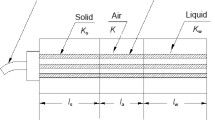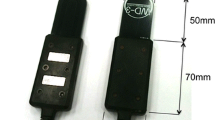Abstract
The development of site-specific crop management is constrained by the availability of sensors for monitoring important soil and crop related conditions. A mobile time-domain reflectometry (TDR) unit for geo-referenced soil measurements has been developed and used for detailed mapping of soil water content and electrical conductivity within two research fields. Measurements made during the early or late season, when soil moisture levels are close to field capacity, are related to the amount of plant available water and soil texture. Combined measurements of water content and electrical conductivity are closely related to the clay and silt fractions of a variable field. The application to early season field mapping of water content, electrical conductivity and clay content is presented. The water and clay content maps are to be used for automated delineation of field management units. Based on a spatial analysis of the soil water measurements, recommendations are made with respect to sampling strategies. Depending on the variability of a given area, between 15 and 30 ha can be mapped with respect to soil moisture and electrical conductivity with sufficient detail within 8 h.






Similar content being viewed by others
References
Baker, J. M., & Allmaras, R. R. (1990). System for automating and multiplexing soil moisture measurements by time-domain reflectometry. Soil Science Society of America Journal, 54, 1–6.
Broge, N. H., Thomsen, A. G., & Greve, M. H. (2004). Prediction of topsoil organic matter and clay content from measurements of spectral reflectance and electrical conductivity. Plant Soil Science, 54, 232–240.
Dalton, F. N., & van Genuchten, M. (1986). The time-domain reflectometry method for measuring soil water content and salinity. Geoderma, 38, 237–250.
Frogbrook, Z. L. (1999). The effect of sampling intensity of the reliability of predictions and maps of soil properties. In J. V. Stafford (ed.), Precision Agriculture ‘99. Proceedings of the 2nd European conference on precision agriculture (pp. 71–80). Sheffield, UK: Sheffield Academic Press.
Heimovaara, T. J., & Bouten, W. (1990). A computer controlled 36-channel time-domain reflectometry system for monitoring soil water contents. Water Resources Research, 26, 2311–2316.
Herimovaara, T. J. (1993). Design of triple wire time domain reflectometry probes in practice and theory. Soil Science Society of America Journal, 57, 1410–1417.
Kerry, R., & Oliver, M. A. (2003). Variograms of ancillary data to aid sampling for soil surveys. Precision Agriculture, 4, 261–278.
Long, D. S., Wraith, J. M., & Kegel, G. (2002). A heavy-duty TDR soil moisture probe for use in intensive field sampling. Soil Science Society of America Journal, 66, 396–401.
Robinson, D. A., Jones, S. B., Wraith, J. M., Or, D., & Friedman, S. P. (2003). A review of advances in dielectric and electrical conductivity measurement in soils using time domain reflectometry. Vadose Zone Journal, 2, 444–475.
Thomsen, A. (1994). Program AutoTdr for making automated TDR measurements of soil water content. SP report No. 38, Danish Institute of Agricultural Sciences, (Tjele, Denmark), 32 pp.
Topp, G. C., Davies, J. L., & Annan, A. P. (1980). Electromagnetic determination of soil water content: Measurement in coaxial transmission lines. Water Resources Research, 16, 574–582.
Topp, G. C., & Reynolds, W. D. (1998). Time domain reflectometry: A seminal technique for measuring mass and energy in soil. Soil & Tillage Research, 47, 125–132.
Tyndale-Biscoe, J. P., Moore, G. A., & Western, A. W. (1998). A system for collecting spatially variable terrain data. Computers and Electronics in Agriculture, 19, 113–128.
Webster, R., & Oliver, M. A. (2001). Geostatistics for environmental scientists. UK: Wiley & Sons, pp 271.
Acknowledgements
Kristian Furdal contributed to the work on the relationship between TDR measurements and soil texture while working on his master’s thesis at the Dept. of Agroecology and Environment.
Author information
Authors and Affiliations
Corresponding author
Rights and permissions
About this article
Cite this article
Thomsen, A., Schelde, K., Drøscher, P. et al. Mobile TDR for geo-referenced measurement of soil water content and electrical conductivity. Precision Agric 8, 213–223 (2007). https://doi.org/10.1007/s11119-007-9041-1
Published:
Issue Date:
DOI: https://doi.org/10.1007/s11119-007-9041-1




